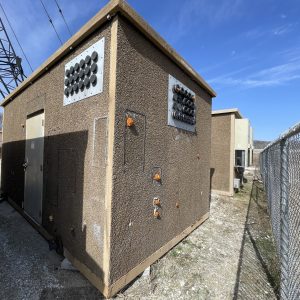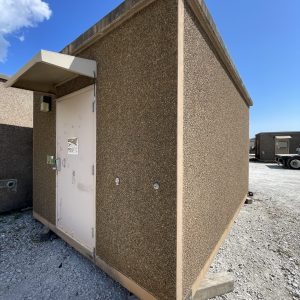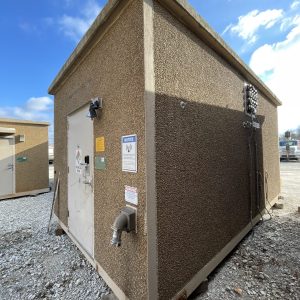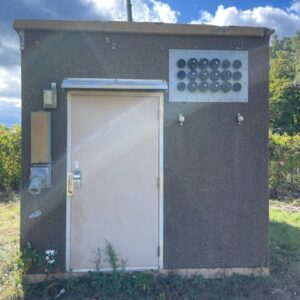Shelter Manufacturers
Tower Direct carries a large line of shelters from the most recognized telecom and equipment shelter producers in the country (and the world). These brand name shelters are designed and built to endure all-weather conditions and provide secure shelter for the most sensitive and valuable equipment.
Andrew Corporation: once a manufacturer of aboveground shelters for telecom,cable, and utility company equipment, Andrew Corporation was acquired by CommScope in 2007. Original Andrew concrete shelters are fabricated with 4-inch panels of lightweight reinforced concrete. They are fire, bullet, vandal, and weather resistant.
CellXion: considered one of the largest US manufacturers of shelters. Sabre Building Systems by CellXion specializes in telecom shelters for nearly all applications. Their shelter products include concrete, aluminum, and fiberglass structures, available in many sizes.
Dupont: specializing in shelters for the communications industry since 1982. Dupont’s products reflect their commitment to providing “environmentally sound, non-corrosive fiberglass equipment shelters.” These fiberglass shelters can safely be situated in any environment and provide the maximum in equipment protection.
Emerson Shelters (Emerson Network Power): a division of the global manufacturing and technology company, Emerson. Emerson Network Power shelters can be found in nearly any industry, protecting oil and gas, military, optical networks, telecommunications, data network, mining, and signaling equipment. Emerson provides a full line of multi-purpose indoor and outdoor enclosures, cabinets, and shelters that can be safely situated at even the most remote sites.
Fibrebond Shelters: founded in 1982 primarily as a manufacturer of concrete buildings for the microwave communications industry. Fibrebond now offers concrete and fiberglass shelters for telecommunications, education, and corrections markets. Fibrebond structures are “designed to meet all zoning and permitting requirements.” Fibrebond’s concrete shelters are built to withstand 150 mph wind load, and IBC Seismic Site Class D hazards.
Fort Worth Tower Company: manufacturer of custom steel and prefabricated aluminum shelters. FTW has designed and manufactured shelters for sensitive equipment for many utility and telecom industries. FTW’s shelters are designed and manufactured to withstand the elements while meeting communities’ increasing emphasis on aesthetics for shelter structures.
Gichner Shelter Systems: manufacturing cabinets and shelters for nearly 45 years. Gichner’s shelter systems are found extensively in tactical military shelters and containerized systems. Gichner manufactures aluminum structures that can be easily put in place and quickly relocated, as needed. Their shelters and cabinets are utilized in nearly every shelter situation – from housing valuable electronics to providing field personnel offices, command and communications centers, medical clinics, and temporary quarters.
Kullman Equipment Shelters: diversity is part of Kullman’s history. Kullman began manufacturing diners in the 1920s eventually expanding to prefabricated housing and other structures, and equipment shelters. Kullman shelters are steel framing and roofing structures made of non-combustible construction. They are designed to protect equipment against ice, rain, snow, wind, lightening, and other environmental conditions; shelters are also deemed to be vandal and bullet resistant.
Oldcastle Shelters: made from steel-reinforced precast concrete. Oldcastle building shelters are utilized in government and military settings, power and energy, transportation, water and specialty environments where security of supplies and equipment is required. Oldcastle shelters are manufactured of steel reinforced precast concrete. They are durable and built for long years of service.
Powerwave Technologies: Powerwave was once a major global telecommunications corporation. Although it no longer is in business, the durable Versaflex shelters it manufactured for the telecom industry are still in use.
Precision Quincy Shelters: now part of The Armor Group. Precision also had an interesting start in 1943, manufacturing (among other products) teletype machine casings for the war effort. Over the years, Precision expanded its products and services, specifically in sheet metal fabrication that included storage buildings for hazardous materials. Sheet metal fabrication transitioned into light-weight metal and concrete shelters for use in such diverse industries as railroads, public safety, telecommunications, utilities, and alternative energy.
ROHN: until the equipment enclosures unit was spun off to Modular Connections, LLC, ROHN manufactured four product lines of shelters including lightweight, fiberglass, and high strength concrete shelters. ROHN’s shelters were/are “built to last.” ROHN now focuses on design and manufacture of towers, poles and antennae but Modular Connection continues ROHN’s tradition of high quality shelter production.
Shelter Technologies, Inc.: a division of United Concrete. Shelter Technologies is known as a major supplier to some of the world’s largest telecommunications companies. Their shelters are also in service at utilities and natural gas, parks and recreation, military, industrial, public, and construction site locations. Shelters are designed and engineered to meet the most stringent requirements for structural integrity, all-weather protection, and maximum security. Shelter Technologies’ motto is, “Rock Solid, Our Buildings… Our commitment!”
Specialist Services Shelters: part of JST of Thailand and South East Asia. Specialist shelters are manufactured in varying sizes and designed to be easily placed in difficult-to-access sites. Their shelters are in service in extreme environments like the Arctic, the Middle East, and Africa. Designed specifically for the telecommunication industry, Specialist’s shelters have 25+ years of experience manufacturing shelters and cabinets for high voltage equipment. Their products are manufactured of strong, long-lasting fiberglass composite and can withstand heavy snow loads, extreme heat and cold, and high winds.
Sun West Engineering Shelters: Sun West focuses on developing and providing solutions for the communications industry, including cabinets and shelters. Their cabinets are Zone 4 compliant for enduring high winds, heavy snow weights, and square foot loading. Designed to be lighter weight, Sun West shelters and cabinets can be easily transported, assembled, and placed in restricted or difficult-access sites.
Switzer Industries Shelters: dba Shelter Works. These shelters are designed and manufactured to be the “strongest, longest-lasting fiberglass composite shelters.” Their trademarked FiberBeam Technology utilizes a composite lamination process to provide superior strength as well as structural stability and integrity in all walls, doors, and roof. Switzer shelters are used in highly diverse industrial settings.
Thermo Bond Shelters: lightweight prefabricated wood or steel-framed buildings, or ground-mounted, pre-cast concrete buildings. Thermo Bond shelters provide valuable equipment, instruments, and even chemicals with year-round protection.
Tracom Fiberglass Products: all-weather, multipurpose shelters. Tracom manufactures one-piece fiberglass buildings that require no maintenance and are not prone to decay or rust. The one-piece construction gives Tracom fiberglass shelters high strength while eliminating joints and seams. Durable and strong, they will shelter equipment in high wind, snow, and Zone 4 seismic loadings environments.
VFP Shelters: prefabricated shelters for telecommunications, power, and modular building industries. VFP has 45 years of designing and manufacturing a diverse product line of shelters.VFP concrete shelter are reinforced solid concrete construction, making them “bullet, vandal, and fire resistant.” Walls, roof, and floor panels are welded together as a single unit for strength, and each panel has a double seal for greater weather protection. VFP offers lightweight shelters of prefabricated structural, non-corrosive type metals treated with rust inhibitive protection (“galvaneal” coated) to eliminate metal corrosion potential.






























